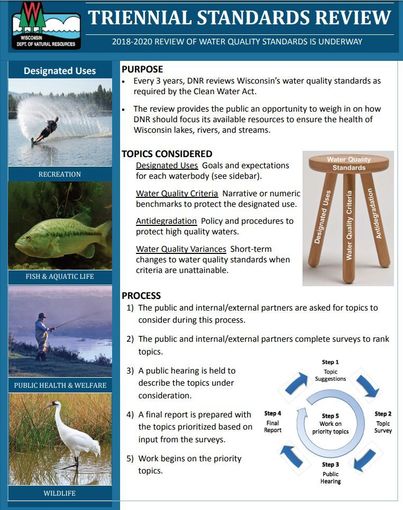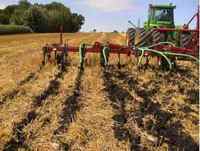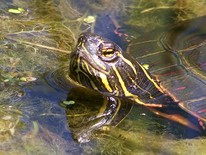
Every three years, the DNR reviews Wisconsin's water quality standards or related guidance for development and revision as required by the federal Clean Water Act. This comprehensive evaluation, called the Triennial Standards Review (TSR) [PDF], is an essential process to keep Wisconsin's waters swimmable, fishable and drinkable. The 2018-2020 Triennial Standards Review is now available from the Wisconsin Department of Natural Resources after a year-long review and public comment period identified areas for improvement.
The 2018-2020 Triennial Standards Review helps DNR staff focus efforts to integrate the latest science, technology, and federal requirements into how the state regulates water quality and helps keep Wisconsin's surface waters swimmable, fishable, and drinkable. The final report, which is reviewed and updated every three years, is required by the federal Clean Water Act. It can be found at https://dnr.wi.gov/topic/surfacewater/tsr.html.
The comprehensive evaluation sets priorities for the next three years and includes developing guidance on bacteria that cause blue-green algae blooms, revisions to the human health criteria, regulation of mercury levels, designating exceptional resource waters, and developing criteria for perfluorinated compounds such as perfluorooctane sulfonate (PFOS), a substance commonly used in fire-fighting foams and non-stick coatings.
CONTACTS: Marcia Willhite, DNR Natural Resources Program Manager, 608-267-7425

In Jefferson County, Kirsten Jurcek worked with NRCS to implement a prescribed grazing plan through the Environmental Quality Incentives Program. She also enrolled in the Conservation Stewardship Program and established an agricultural conservation easement on her acreage. Read more
With the incredibly challenging financial and emotional situation plaguing the majority of farm families in our communities, UW-Extension Manitowoc, Fond du Lac, Calumet, Sheboygan, Ozaukee, and Washington Counties will be hosting “Supporting Farmers During Challenging Times” on Wednesday, January 9th, 2019, 9 am to 12 noon at Millhome Supper Club, Kiel.
This one-half day meeting is designed to help agribusiness professionals and agency staff feel more comfortable and confident working with families in distress, and to connect with others to provide support for the farming community. The agenda includes:
- Farm Finances: Analysis to Action
- Coping with the Pressures of Farm Life: Tools to Support Those Struggling
- Strategies to Deal with the New Financial Normal: Nutrition and Beyond
The meeting is open to all individuals wishing to learn more on how to support their farm families and clientele. Cost to attend is $5 per person which includes light refreshments and materials. Kindly RSVP by January 4 if you plan to participate by visiting https://goo.gl/K4k2to or calling UW-Extension Fond du Lac County at 920.929.3171.
Dairy farmers, consultants, and service providers interested in learning more about automatic milking systems technology are encouraged to attend the Building Our Dairy Future: Robotic Milking Systems Performance and Efficiency Seminar scheduled for Monday, January 28, 2019. The seminar will be held at the Osthoff Resort, Elkhart Lake, Wisconsin beginning with registration at 10 am.
The program will start at 10:30;
- “Robotic Facilities Design Considerations”
- “Economics of Automatic Milking Systems”
- "Labor efficiency of automatic milking system barns"
- “The Good, The Bad, and The Unknown” - a panel discussion on a single robotic dairy farm along with their lender and builder.
For details, please visit Building Our Dairy Future: Robotic Milking Systems
|

Aquatic Plant Management Strategic Analysis - Comment Period
Contacts: Carroll Schaal, lakes and rivers section chief, 608-261-6423 or James Pardee, environmental analyst, 608-316-0999
MADISON—The Department of Natural Resources invites the public to comment on its draft Strategic Analysis of Aquatic Plant Management (APM) in Wisconsin. The report, which summarizes current information on APM in the state, serves as an informational resource to help decision-makers and the public to better understand the topic and to aid in the development of future APM policy.
Aquatic plants are a critical part of the state’s freshwater environment. They help to ensure good water quality and clarity, provide habitat and food for fish and wildlife, and serve many other valuable functions. Sometimes, though, aquatic plants can become overabundant and interfere with water uses. Managing these problems is complicated by the fact that some of the DNR rules governing APM have not been updated since 1986, while APM practices and challenges have evolved.
The draft Strategic Analysis report and links to more information about APM can be found on the department’s APM strategic analysis webpage, or by searching for the key words “aquatic plant management” on the department website, dnr.wi.gov.
Comments on this strategic analysis may be submitted through January 25, 2019, by email to
DNRAPMSA@wisconsin.gov or sent via US Mail to Carroll Schaal, lakes and rivers section chief, 101 S. Webster Street, Madison, WI 53707-7921.
|

Watershed Program Associate
Clean Lakes Alliance seeks a full-time Watershed Program Associate to join its passionate and dedicated team. Primary duties relate to the day-to-day planning and implementation of watershed engagement programs, including educational initiatives, volunteer-participation opportunities, and citizen actions. This position also assists with efforts to advance community projects related to phosphorus and stormwater reduction, including urban green infrastructure. Position Description
|

The 2018 Annual Report online form is now available in the MS4 eReporting System. The annual report is due March 31, 2019, and the online form is required to be filled out and submitted electronically via the eReporting system.
A copy of the 2018 Municipal Separate Storm Sewer (MS4) Annual Report PDF form is available on the DNR Municipal storm water eReporting web page. Municipalities may use this PDF form to route for information collection for calendar year 2018. We will not accept an uploaded or emailed Annual Report PDF form.
How to access Water Permit Portal, choose Storm Water: http://dnr.wi.gov/permits/water/
Additional information and resources for MS4 eReporting Includes User Support Tools, and the Delegation of Signature Authority form: http://dnr.wi.gov/topic/stormwater/municipal/eReporting.html
Notable changes to 2018 form
- Measures 1 & 2 Tabs: “Target Audiences, Target Participants” for Public Education and Outreach and Public Participation and Involvement. These are currently optional but will be required in the 2020 Annual Report per EPA requirements.
- Attachments Tab: Required attachments, if updated: Municipal Facility SWPPP, Storm Sewer System Map.
More information about MS4 permits: http://dnr.wi.gov/topic/stormwater/municipal/
Final Storm Water Technical Standards Available: Non-Channel Erosion Mat – Technical Standard 1052 and Channel Erosion Mat – Technical Standard 1053
Final technical standards and response to comments relating to storm water are now available on the Proposed DNR Program Guidance web page.
The proposed “Non-Channel Erosion Mat – Technical Standard 1052” and “Channel Erosion Mat – Technical Standard 1053” have been revised, which include minor updates relating to formatting, references, and terminology. These standards are posted on the DNR’s storm water construction technical standards web page.
|

The deadline for participating counties to sign up is January 1, 2019. As of Dec 28, 2018, 24 counties have signed up to participate in the MDV. A preliminary estimate of potential funds that may be available by HUC8 watershed is located here (with participating counties highlighted in orange);
The participating counties (as of 12/28/2018) include;
- Barron
- Brown
- Calumet
- Chippewa
- Fond du Lac
- Grant
- Iowa
- Juneau
- Lafayette
- Lincoln
- Manitowoc
- Marathon
- Monroe
- Outagamie
- Ozaukee
- Pierce
- Racine
- Sauk
- Shawano
- Trempealeau
- Waupaca
- Waushara
- Winnebago
- Wood
Funding will be made made available based on the percentage of HUC 8 watershed that a given county occupies. If a county does not participate in the MDV, that county’s funding may be redistributed to participating counties within the HUC 8 watershed. In early January we will work to distribute “unclaimed” funding to participating counties. Facilities will be invoiced in the beginning of February, indicating which counties to direct payment to, with the payment due March 1st.
Fore more information;
Wastewater policy updates are available via the program DNR webpage;
If you prefer to receive updates via Gov-Delivery;
|

Each month Sweet Water compiles a list of local, regional, and national funding opportunities. These grants and scholarships are available for environmental and water quality projects in our region and are intended to support a range of needs, from organizational capacity building to water quality monitoring. We encourage our partner organizations and community members to take a closer look!
Find the full list here!
|
|